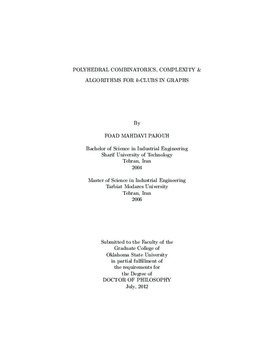| dc.contributor.advisor | Balasundaram, Balabhaskar | |
| dc.contributor.author | Mahdavi Pajouh, Foad | |
| dc.date.accessioned | 2013-12-10T18:05:04Z | |
| dc.date.available | 2013-12-10T18:05:04Z | |
| dc.date.issued | 2012-07 | |
| dc.identifier.uri | https://hdl.handle.net/11244/7774 | |
| dc.description.abstract | A k-club is a distance-based graph-theoretic generalization of clique, originally introduced to model cohesive subgroups in social network analysis. The k-clubs represent low diameter clusters in graphs and are suitable for various graph-based data mining applications. Unlike cliques, the k-club model is nonhereditary, meaning every subset of a k-club is not necessarily a k-club. This imposes significant challenges in developing theory and algorithms for optimization problems associated with k-clubs. | |
| dc.description.abstract | We settle an open problem establishing the intractability of testing inclusion-wise maximality of k-clubs for fixed k>=2. This result is in contrast to polynomial-time verifiability of maximal cliques, and is a direct consequence of k-clubs' nonhereditary nature. A class of graphs for which this problem is polynomial-time solvable is also identified. We propose a distance coloring based upper-bounding scheme and a bounded enumeration based lower-bounding routine and employ them in a combinatorial branch-and-bound algorithm for finding a maximum k-club. Computational results on graphs with up to 200 vertices are also provided. | |
| dc.description.abstract | The 2-club polytope of a graph is studied and a new family of facet inducing inequalities for this polytope is discovered. This family of facets strictly contains all known nontrivial facets of the 2-club polytope as special cases, and identifies previously unknown facets of this polytope. The separation complexity of these newly discovered facets is proved to be NP-complete and it is shown that the 2-club polytope of trees can be completely described by the collection of these facets along with the nonnegativity constraints. | |
| dc.description.abstract | We also studied the maximum 2-club problem under uncertainty. Given a random graph subject to probabilistic edge failures, we are interested in finding a large "risk-averse" 2-club. Here, risk-aversion is achieved via modeling the loss in 2-club property due to edge failures, as random loss, which is a function of the decision variables and uncertain parameters. Conditional Value-at-Risk (CVaR) is used as a quantitative measure of risk that is constrained in the model. Benders' decomposition scheme is utilized to develop a new decomposition algorithm for solving the CVaR constrainedmaximum 2-club problem. A preliminary experiment is also conducted to compare the computational performance of the developed algorithm with our extension of an existing algorithm from the literature. | |
| dc.format | application/pdf | |
| dc.language | en_US | |
| dc.rights | Copyright is held by the author who has granted the Oklahoma State University Library the non-exclusive right to share this material in its institutional repository. Contact Digital Library Services at lib-dls@okstate.edu or 405-744-9161 for the permission policy on the use, reproduction or distribution of this material. | |
| dc.title | Polyhedral combinatorics, complexity and algorithms for k-clubs in graphs | |
| dc.contributor.committeeMember | Ingalls, Ricki | |
| dc.contributor.committeeMember | Kamath, Manjunath | |
| dc.contributor.committeeMember | Sharda, Ramesh | |
| osu.filename | MahdaviPajouh_okstate_0664D_12291.pdf | |
| osu.accesstype | Open Access | |
| dc.type.genre | Dissertation | |
| dc.type.material | Text | |
| dc.subject.keywords | 2-club polytope | |
| dc.subject.keywords | clique relaxations | |
| dc.subject.keywords | combinatorial algorithms | |
| dc.subject.keywords | conditional value-at-risk | |
| dc.subject.keywords | graph-based data mining | |
| thesis.degree.discipline | Industrial Engineering and Management | |
| thesis.degree.grantor | Oklahoma State University | |
